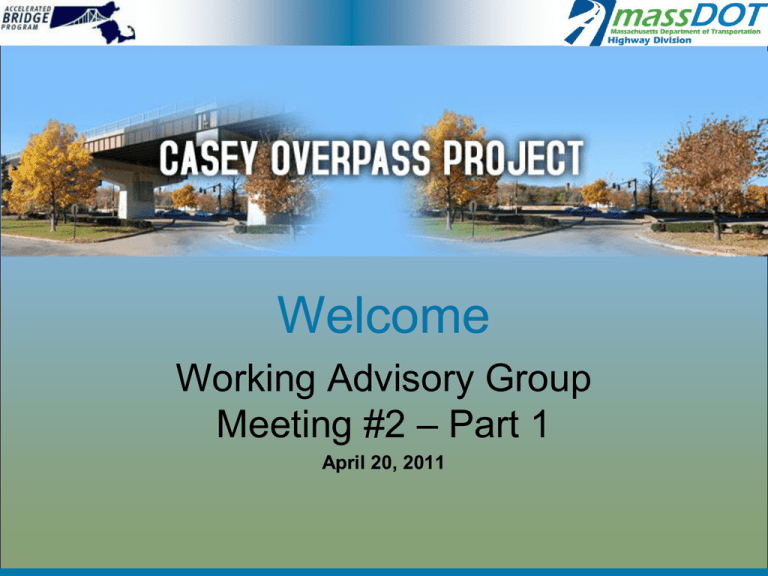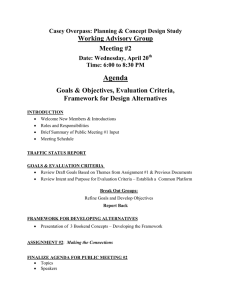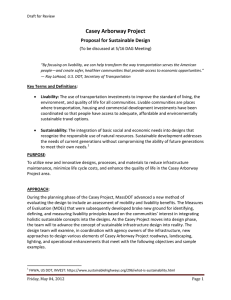Welcome Working Advisory Group Meeting #2 – Part 1 April 20, 2011
advertisement

Welcome Working Advisory Group Meeting #2 – Part 1 April 20, 2011 Planning Study Public Meeting Schedule Meeting 1 Project Purpose, Goals and Existing Conditions Meeting 2 Issues & Opportunities, Evaluation Criteria, 2035 Traffic Projections, Framework for Design Alternatives Meeting 3 Development of Alternatives, Refinement of Evaluation Criteria Meeting 4 Finalization of Alternatives, Apply Evaluation Criteria Meeting 5 Selection of Preferred Alternative Today’s Agenda Welcome & Introductions Traffic Status Report Goals, Objectives & Evaluation Criteria Framework for Developing Conceptual Alternatives Assignment #2: Making the Connections Welcome New Members WAG Role & Responsibilities Summary of Public Meeting #1: Project Overview, Existing Conditions, Imagine the Possibilities Traffic Status Update Existing Conditions Future Conditions Coordination with CTPS and the City of Boston Goals, Objectives and Evaluation Criteria Guiding Principles: •Address a structurally deficient bridge. •Protect and respect the design for Arborway Yards. •Improved safety for all users. •Develop alternatives that meet ABP budget and schedule. Sources for Developing Goals: •Community photo logs •Previous studies and plans in the area •Federal Sustainability/Livability •MassDOT/GreenDOT goals •City of Boston Complete Streets Develop a Common Platform for Goals Mobility 1. Improve roadway geometry to enhance circulation for all modes and users 2. Strengthen local and regional corridor connections for all users (e.g., desire lines, interest nodes, gateways, coordinate signals) 3. Improve access and intermodal connections to promote transportation choices (e.g., modal transfers, park N ride, taxis, bike, pedestrian) 4. Integrate sustainability principles into design concepts (e.g., materials, specs, maintenance) Livability 1. Remove Barriers for Neighborhood Connections and Circulation 2. Enhance the Human Connections and Create a Sense of Community Place 3. Integrate Transit with Economic and Residential Areas 4. Celebrate the Area’s Architectural, Historic Transportation and Landscape Features 5. Improve the Visibility, Connectivity and Access to Gateway Open Spaces: Southwest Corridor, Franklin Park, Arnold Arboretum and the Forest Hills Cemetery 6. Enhance the Quality of Life in Residential Areas (e.g., noise, air quality, cut through traffic) BREAK OUT GROUPS Mobility and Livability Confirm Goals Develop Measurable Objectives Report Back The Design Process The Framework for Developing Conceptual Alternatives The Design Framework: What if ……the Casey Overpass is replaced with another bridge? What if ……the focus is only on recreating the Parkway connection (minimum pavement)? What if …….the focus is primarily on vehicular access and circulation at grade (maximized pavement)? The Designer General’s WARNING: The tools we use today for designing and drawing, principally AutoCAD and other software programs, make the process faster, more efficient and make coordination between drawings easier. There is an unfortunate side effect of AutoCAD which is the hard-line style makes all drawings look more finished, more thought out than they may actually be. This often leads people to incorrectly conclude that concepts and ideas shown at the early stages of a design process are finished designs. Let us assure you: this is not the case. What if …… The Casey Overpass is replaced with another bridge? What if -- the Casey Overpass is replaced with another bridge? What if -- the Casey Overpass is replaced with another bridge? What if -- the Casey Overpass is replaced with another bridge? VEHICLE GOOD BAD OPERATIONS LANDSCAPE FULL NONE RESTORATION BICYCLE MORE LESS CONNECTIONS PEDESTRIAN MORE CONNECTIONS LESS TRANSIT GOOD OPERATIONS BAD GATEWAYS MORE HIGHLIGHTED LESS What if …… The focus is only on recreating the Parkway connection (minimum pavement)? What if --the focus is only on recreating the Parkway connection? What if --the focus is only on recreating the Parkway connection? Olmsted’s 1892 Plan Key Points • Separation of modes • Tree lined buffers VEHICLE GOOD BAD OPERATIONS LANDSCAPE FULL NONE RESTORATION BICYCLE MORE CONNECTIONS LESS CONNECTIONS LESS PEDESTRIAN MORE TRANSIT GOOD OPERATIONS BAD HIGHLIGHTED LESS GATEWAYS MORE What if …… the focus is primarily on vehicular access and circulation at grade (maximized pavement)? What if …. the focus is primarily on vehicular access and circulation at grade? VEHICLE GOOD BAD OPERATIONS LANDSCAPE FULL NONE RESTORATION BICYCLE MORE LESS CONNECTIONS PEDESTRIAN MORE LESS CONNECTIONS TRANSIT GOOD BAD OPERATIONS GATEWAYS MORE HIGHLIGHTED LESS DESIGN CONSIDERATIONS Relocation of Surface Parking Route 39 Bus Loop Grade variations: sight line issues Shea Circle Access Controls: curb cuts, signals Orange Line exhaust stack and exit stair Commuter Rail ventilation grates Ventilation and Exit Stair Assignment #2 Making the Connections Due to HNTB by May 4, 2011 Insert Example Agenda for Working Advisory Group Meeting #2 - Part 2 May 4, 2011 Traffic Update Finalize Objectives for Evaluation Criteria Final Agenda for Public Meeting #2 – Topics & Speakers Assignment #2 DUE TODAY! Agenda for Public Meeting #2 May 18, 2011 Welcome Goals, Objectives & Evaluation Criteria Traffic Update Framework for Developing Conceptual Alternatives Assignment #2: Making the Connections Thank You for Your Ideas !

